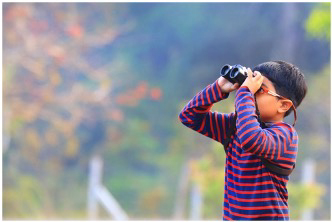   |
Students who are attending online classes, part of the week or throughout the week, can add bird feeding and observations to their daily schedule. Getting outside and seeing what birds are in their backyards gives young learners a break from the routine (and the computer or tablet screen). Birding is a natural fit with science lessons, but it also promotes cognitive abilities related to discovery and physical activity, while at the same time providing a sense of calm. Feeding and studying birds makes learning more enjoyable and ties children to nature and the outdoors.
“The new school year is quite a different experience than in the past,” said George Petrides, Jr., CEO of Wild Bird Centers of America. “We know learning from home isn’t easy, but we can make it more joyful by taking education outside, where kids will discover and learn about nature in an interactive way and boost their spirits at the same time.”
Feeding and observing backyard birds can be a part – and a highlight – of a student’s daily curriculum. Petrides added, “Schools across the country have long recognized that birding and feeding hobby as beneficial to their students. Many nursery, elementary, junior highs, and high schools have incorporated feeders, bird houses, and bird baths into their landscaping and courtyards. Adding one at home continues this practice.”
Birds bridge cultural and geographic barriers, offering connections to everyone in the world. Anyone can take part in this activity – whether you are schooling at home, working from home, or after you’ve returned home from school and work. Birds are everywhere, and students can enjoy birding with binoculars during a walk through your backyard, neighborhood, a nearby park, or on a field trip to a nature center or wildlife refuge.
The variety we find in birds turns looking for them and seeing which ones come to visit feeders into a true treasure hunt. Learning more about the animals that live in our yards and surrounding area gives children a better understanding and appreciation of the environment and an awareness of the interconnectedness of all living things. For some people, birding has even peaked their interest in pursuing future study in science, conservation, or natural history. And even just an introduction to birds and the forms of backyard birding that tens of millions of people enjoy can make us more informed about nature and the importance of landscaping and natural areas.
“The key to getting children engaged is to make sure a bird feeder is easily seen from wherever they hang out,” Petrides said. “Let the birds do what they do best – entertain, educate, and fascinate!”
Let the children add foods to the feeders, whether it is a suet feeder for woodpeckers, nuthatches, and chickadees; a nectar feeder for hummingbirds, a platform or hopper feeder for seeds, or all of the above, attending a feeder or feeding station gives kids a sense of responsibility and a little break from indoor activities.
Providing a shallow water basin or a pedestal bird bath filled with fresh water is sometimes even more important than providing food. Encourage children to identify the birds they see using a field guide to birds, and to keep a list of the birds they see to add even more value to their bird feeding experience.
The fun thing about birds and feeding birds is that each day is different, you never know what birds might appear before you at any moment, and the actions of birds near our windows gives us something to look forward to each day in addition to our school, work, and home activities.
This article was prepared by Wild Bird Centers of America, a nationally recognized brand and successful chain of retail stores. To learn more about Wild Bird Centers and review their complete line of quality products that are designed to deliver better backyard bird feeding experiences for birders, young and old. See https://www.wildbird.com/
Share your birding experiences and photos at editorstbw2@gmail.com
